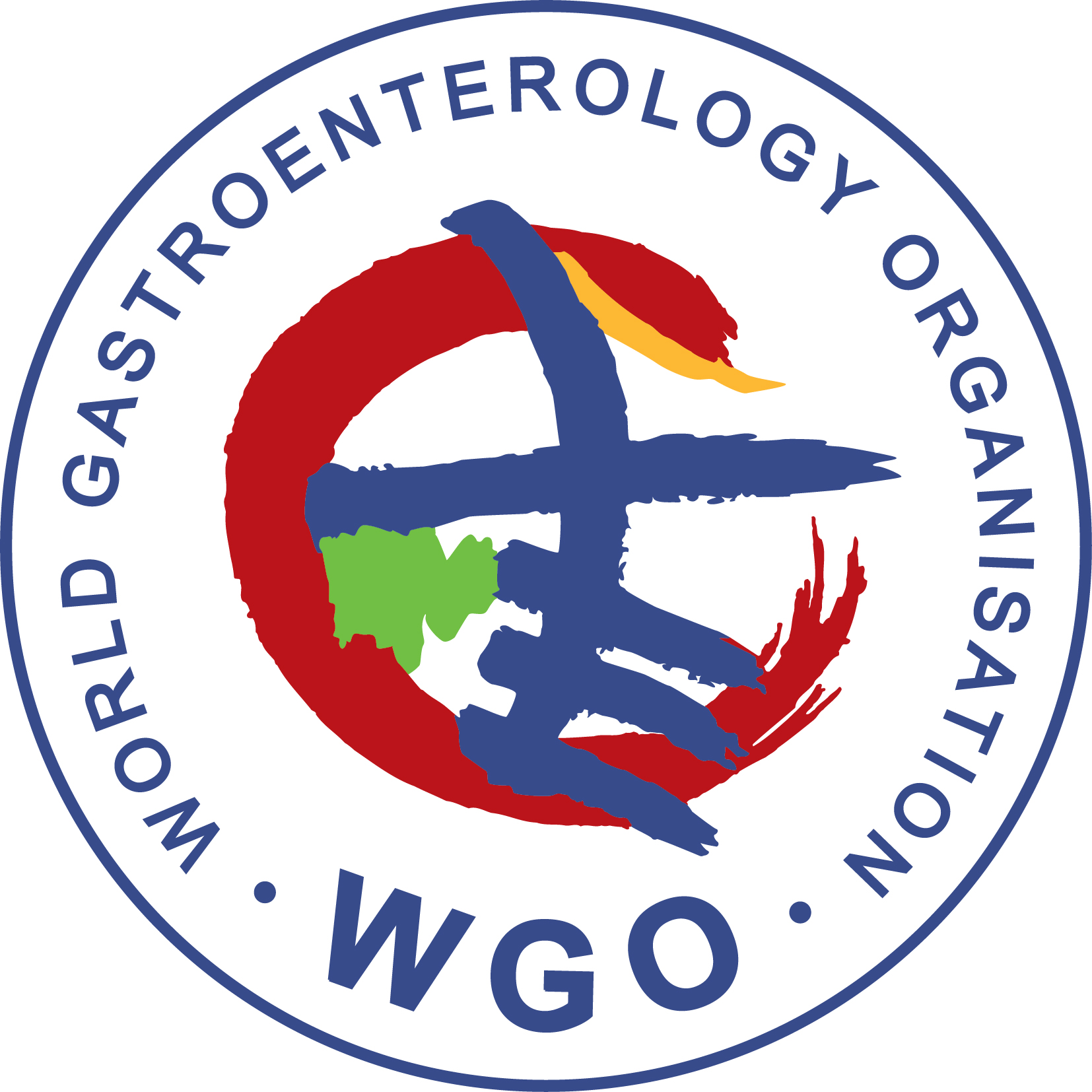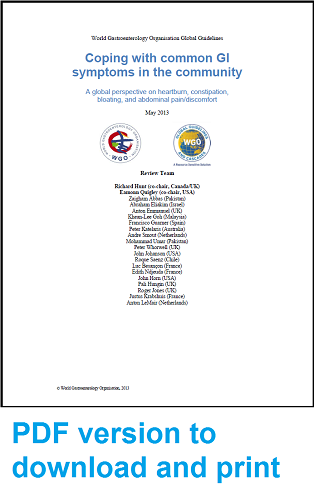This guideline on a World Digestive Health Day (WDHD) theme is the first to take four key gastrointestinal (GI) symptoms as its starting-point: heartburn, abdominal pain/discomfort, bloating, and constipation. It is also unique in featuring four levels of care in a cascade approach: self-care and “over-the-counter” aids; the pharmacist’s view; the perspective of the primary care doctor—where symptoms play a primary role in patient presentation; and the specialist. The aim is to provide another unique and globally useful guideline that helps in the management of common, troubling but not disabling GI complaints. A team of gastrointestinal and primary care experts, as well as the International Pharmaceutical Federation (FIP), were involved in the creation of the guideline.
GI symptoms—with the possible exception of heartburn—usually occur as chronic or recurrent complaints attributed to the pharynx, esophagus, stomach, biliary tract, intestines, or anorectum. While some data are available on the epidemiology of individual symptoms, there are more on the symptom clusters or aggregations known as functional gastrointestinal disorders (FGIDs)—disorders as yet not explained by structural or biochemical abnormalities. These disorders affect a large segment of the population, and comprise a large proportion of primary care and gastroenterology practice. A categorization of these symptoms into discrete functional gastrointestinal disorders has been developed in a multinational consensus in accordance with predefined symptom criteria [1].
Relatively few data are available on the epidemiology of individual symptoms (with the exception of constipation), although there are considerable data on FGID syndromes. The latter are frequently used as a surrogate for the former throughout this guideline—e.g., gastroesophageal reflux disease (GERD) for heartburn, irritable bowel syndrome (IBS) for abdominal pain/bloating.
In addressing any disorder in the community, it is important to distinguish between diagnosed and undiagnosed GI problems; there is a huge reservoir of people who have problems and who have not been given a specific diagnosis by their clinician [2]. In dyspepsia, there is evidence that only 50% of sufferers actually consult their doctor [3]. The reasons for consultation may be determinants of management.
Local or regional disease epidemiology is relevant to the management of these GI problems: the prevalence of parasitic diseases such as worms, Giardia, and viruses, as well as the incidence of malignant diseases, need to be considered. For example, in Mexico, giardiasis; in South-East Asia, hepatitis viruses; and in the southern regions of the Andes, gastric and gallbladder cancer need to be considered in the differential diagnosis.
There are also cultural and religious aspects that modify the patient’s response to symptoms: the Japanese population is recognized for being pain-tolerant; in other cultures, showing resistance to pain or other complaints may be regarded as a sort of sacrifice that can be beneficial for the soul and future life. Coping with environmental or psychological stressors such as war, migration, starvation, sexual abuse, or bullying may be very important in the causation of diseases and symptoms. Finally, in some cultures, spicy foods are a real issue.
1.1 Epidemiology of functional gastrointestinal symptoms
Between-country variations in the occurrence rates for abdominal symptoms must be interpreted with caution; they may also reflect differences in culture, language, or expression, as well as study methods [4].
Cultural differences are likely to cause differences in [5]:
- Perception of symptoms—differences in ideas and concerns
- Presentation to medical care (including access to care)
- Use of medication
- Preferred types and patterns of treatment
- Expectations for treatment outcome
- Relative availability of over-the-counter (OTC) and prescription drugs
1.1.1 North America/United States
In 1993, Drossman et al. [1] reported data from a householder survey in the United States on the prevalence of 20 functional gastrointestinal disorders, based on the fulfillment of multinational diagnostic (Rome) criteria.
- Sixty-nine percent of patients reported having had at least one of 20 functional gastrointestinal disorders during the previous 3 months. The symptoms were attributed to four major anatomic regions, with considerable overlap:
- Intestinal: 44%
- Esophageal: 42%
- Gastroduodenal: 26%
- Anorectal: 26%
- Females reported higher frequencies of dysphagia, irritable bowel syndrome, constipation, abdominal pain, and biliary pain than males.
- Males reported higher frequencies of bloating than females.
- Symptom reporting, except for incontinence, declined with age.
- Low socio-economic status, low educational attainment, and low income were associated with greater symptom reporting.
1.1.2 Europe/Western countries
- Functional disorders of the gastrointestinal tract are estimated to occur in up to 30% of the adult population in Western countries [6,7] and are recognized as a frequent cause of abdominal pain. Only 20–50% of these symptoms can be formally attributed to IBS [1,8].
- In IBS, abdominal pain and/or discomfort is the central symptom; other intestinal symptoms are altered bowel habit, which may be dominated by constipation or diarrhea or may alternate between them, as well as abdominal bloating, distension, or flatulence [8,9].
- The term “IBS” appears to be largely limited to the Anglo-Saxon world, and is perhaps overused as a loose description of functional symptoms. In other countries, similar complaints are usually referred to as abdominal cramping and pain, abdominal discomfort, or abdominal disorder [4].
- Chronic constipation is the commonest functional GI symptom in European populations, with almost one in five people being diagnosed, depending on the criteria used. There is controversy about the value of applying the strict Rome III criteria for diagnosis of constipation, with poor construct validity and a 10% false-negative rate being reported in one series [10]. Amongst the elderly and institutionalized population, over 50% of patients require laxatives [11].
- GERD symptoms are increasingly prevalent in the United States, as well as in the rest of the world. In the United States, El-Serag [12] has reported a 4% increase per year in the prevalence of weekly GERD symptoms. Much of this increase relates to the increasing weight and changes in other lifestyle factors seen in European and North American populations, especially urban ones [13].
1.1.3 Asia
- A recent study reported a 16% prevalence of GERD in an urban adult population in northern India, which is similar to that seen in other industrialized countries [14].
- A survey in Pakistan reported an overall prevalence of gastroesophageal reflux symptoms of 24%, with 58% reported in males [15]. The prevalences of irritable bowel syndrome, functional constipation, and functional diarrhea were 20%, 25%, and 5%, respectively, among Chinese students. Female students have been found to have a lower bowel frequency than males (P < 0.01) [16]. Studies in Asia suggest that gastrointestinal infections such as giardiasis are common causes of recurrent abdominal pain, but that functional abdominal pain is also prevalent [17]. Abdominal pain–predominant functional gastrointestinal disorders affect 13% of children aged 10–16 years and constitute a significant health problem in Sri Lanka; among 2180 children surveyed, IBS was seen in 107 (4.9%), functional dyspepsia in 54 (2.5%), functional abdominal pain in 96 (4.4%), and abdominal migraine in 21 (1.0%) [18]. In another study from Sri Lanka, FGIDs were present in more than one-quarter of adolescents in the study group, with IBS being the most common [19]. Overlap among GERD, functional dyspepsia, and IBS is common and worsens the health-related quality of life in Asians. The common symptom shared by these disorders is postprandial fullness [20,21]. In some areas such as Turkey, celiac disease may be present among dyspeptic patients and needs to be ruled out [22].
- In a longitudinal population survey of 70-year-olds in Jerusalem, up to one-third complained of upper gastrointestinal symptoms, mainly heartburn, while 10% reported abdominal pain during the previous week, with less than 1% occurring in the lower abdominal quadrants [23].
1.1.4 Latin America—functional GI symptoms
- In a study using Rome II criteria among Chileans [24] over the age of 20, the following data were reported:
- Digestive symptoms 67%; IBS criteria 26% (a high incidence in comparison with other Latin-American data); mean age of onset 41.3 (range 20–66); mean age of symptoms starting at 26.5 years old.
- Patients with symptoms presenting at a medical consultation: 43%.
- More cholecystectomies were found in the IBS group: 30.4 versus 13.7% in the non-IBS group (Chile has a high incidence of gallbladder cancer).
- No differences were found relative to socio-economic status, geographical area, or family history of IBS.
- Madrid et al. [25] also reported that a positive lactulose hydrogen breath test was more frequently found among children with functional symptoms in the digestive tract.
- Subgroups of IBS patients include: functional diarrhea 7%, functional constipation 9%, and functional bloating 23%; there is a higher incidence in women.
- Chronic coca leaf chewing may be of concern in the Andes population in relation to esophageal pathology, and also in connection with colonic disturbances such as megacolon or constipation.
1.1.5 Africa—functional GI symptoms
Functional GI symptoms do occur in Africa, but it is evident that there are large gaps in the data [26–28].
1.2 WGO cascades
The World Gastroenterology Organisation (WGO) has developed diagnostic and treatment cascades for the WGO guidelines in order to provide resource-sensitive recommendations rather than focusing on a gold standard. However, for this guideline, a different approach has been chosen, based on the point of care: from selfcare to pharmacist, general practitioner/family physician, and finally, GI specialist. For the GI specialist, no extensive instructions are provided here, as sufficient sources are available on the Internet and in the published literature; references are provided throughout this guideline.
Patients who are taking medications should consult a pharmacist to see whether the self-medication options mentioned in this document have any labeled contraindications or known interactions with other drugs they may be taking. In some countries, OTC medicines are only available through community pharmacies. In most countries in the world, pharmacists can only recommend OTC medicines (as they do not have prescribing rights) to help patients, while in some other countries there is an intermediate class of medicines: pharmacy-only medicines. It is therefore often challenging to distinguish between management decisions that are based on a pharmacist’s recommendation and those that are truly a choice of self-care. To resolve this issue, both the process (self-care vs. pharmacist-driven) and the solution have been considered here (OTC medicines in both cases).
Still, it should be taken into account that pharmacists systematically review medications for two purposes:
- To determine whether the GI symptoms could be a side effect of a medication
- To determine whether medicines used to treat GI symptoms have any known drug interactions with medicines the patient is already taking
Increasing evidence suggests that dietary [29], lifestyle, cognitive, emotional/behavioral, and broader psychosocial factors may all play a role in the etiology, maintenance, and clinical effectiveness of treatments for functional GI disorders [30].
In interpreting the common symptoms considered in this guideline, a diagnosis of a functional gastrointestinal disorder can be made if the patient’s symptoms are consistent with published diagnostic criteria for a given FGID [31] in the absence of a history suggestive of any structural (organic) diagnosis that might provide an alternative explanation for the symptoms (see below). Age and gender (with no significant interaction) are the most clinically relevant variables.
Diagnostic responsibility is usually limited to medical doctors, and generally excludes self-care and pharmacist’s interventions.
2.1 Functional gastrointestinal symptoms
The numerous functional gastrointestinal symptoms can be attributed to four major anatomic regions: esophageal, gastroduodenal, bowel, and anorectal:
- Esophageal symptoms:
- Functional chest pain
- Functional heartburn
- Functional dysphagia
- Gastroduodenal symptoms:
- Functional dyspepsia
- Ulcer-like dyspepsia
- �Dysmotility-like dyspepsia
- �Unspecified dyspepsia
- Aerophagia
- Bowel symptoms
- IBS
- Functional constipation
- Functional diarrhea
- Functional abdominal bloating
- Chronic abdominal pain
- Functional biliary pain
- �Sphincter of Oddi dyskinesia
- Anorectal symptoms
- Functional incontinence
- �Fecal soiling
- �Gross fecal incontinence
- Functional anorectal pain
- �Levator syndrome
- �Proctalgia fugax
- Difficulty in defecating—dyschezia
The following sections (2.2 and 2.3) provide guidance on evaluating and monitoring the four principal symptoms discussed in this guideline.
2.2 Complaints profile—symptom and patient factors
- Dominant digestive symptoms experienced during episodes—solely or in combination. Location, description:
- Heartburn
- Abdominal pain
- Abdominal cramping
- Abdominal discomfort
- �Bloating, distension, flatulence, other “gas-related” complaints
- �Abdominal pressure, feeling of tightness, fullness
- Abnormal stool habits
- �Diarrhea
- �Constipation
- �Alternating diarrhea and constipation
- �Stool with excessive mucus
- �Urgency
- �Tenesmus
- Other
- �Nausea
- Vomiting
- �Black, tar-like stool
- �Stool containing fresh red blood or streaks of blood and/or mucus
- Temporal factors
- First occurrence (sudden onset)
- Duration of problem—“how long has this been going on?”
- Duration of episodes
- Frequency (always, regularly, occasionally, intermittently)
- Circumstances—relationship to meals, posture, time of the day, bowel movements, menstrual cycle
- Quality of symptom
- Severity—e.g., on a scale of 1 = low to 10 = high (1–4 mild, 5–7 moderate, 8–10 severe)
- Associated distress (on a visual analogue scale)
- Impact on:
- Daily activities
- �Social life
- �Work, school
- �Ability to exercise
- �Eating habits
- �Sleep
- �Sexual activity
- Presence of non-GI symptoms, comorbidities
- Headache
- Fever
- Cough
- Unexplained weight loss
- Link to non-GI events, pregnancy, dysuria, dyspareunia
- Other non-GI symptoms and psychological comorbidities
- Patient factors
- Age, gender
- Lifestyle—smoking, alcohol consumption, eating/diet, exercise, sleep, stress, travels
- Patient’s culture, as related to food and diet
- Patient’s health “literacy” as it may affect his/her capacity for self-care
- Health status—patient history:
- � Current and past symptoms, psychosocial features, family history
- � Concurrent medical conditions—preceding or following
- � Prescription and nonprescription medications, dietary supplements
- Actions taken when symptoms occur:
- Efforts to relieve symptoms
- Self-medication with one or more remedies/drugs
- Visit drug store, pharmacist, health food store, non-medical healer or complementary medical practitioner, acupuncturist
- Consult physician, specialist
- Medication
- Availability of over-the-counter, prescription drugs
- Nonmedical, nontraditional therapies, herbal medicine, acupuncture, etc.
- Treatment expectations
- Type of drug(s) used for the symptom(s)
- Frequency of medication use, dosages
- Timing of treatment—as prevention, on-demand when symptom occurs, or continuous/“maintenance”
- Efficacy and satisfaction level, description of change in symptoms, new symptoms, adverse effects
- Duration of episodes in the presence or the absence of medication
- “Other” medication use
- Symptom reporting
- Rome III diagnostic questionnaires (see http://www.romecriteria.org/questionnaires)
- Behavioral communications—not criteria for the diagnosis:
- Verbal and nonverbal expression of varying pain intensity
- �Urgent reporting of intense symptoms
- �Minimizing or denying a role for psychosocial factors
- �Requesting additional diagnostic studies
- �Focusing attention on complete recovery
- �Seeking health care frequently
- �Taking limited personal responsibility for self-management
- �Making requests for narcotic analgesics
- Medical epidemiological context
- Background rates of Helicobacter pylori infection, gastric cancer, Barrett’s and adenocarcinoma of esophagus
- Access to diagnostic facilities and therapies
2.3 Diagnostic tests for functional gastrointestinal symptoms
- Physical examination
- Basic diagnostic laboratory tests:
- Complete blood cell count (CBC)
- Erythrocyte sedimentation rate (ESR) / C-reactive protein (CRP)
- Biochemistry panel
- Fecal occult blood (patient aged > 50 y)
- Pregnancy test
- Liver function tests
- Calprotectin or other fecal test to detect inflammatory bowel disease in patients thought to have IBS, but in whom inflammatory bowel disease (IBD) is a possibility; now routine in many primary care settings (in the United Kingdom)
- Celiac serology; considered routine in areas with a high prevalence of celiac disease
- Stool testing for ova and parasites
- Endoscopy
- Visible abnormalities
- Biopsy, histology
- pH study—24-hour (48–72-hour with the Bravo esophageal pH capsule) esophageal pH or impedance-pH monitoring: measurement of esophageal acid exposure and assessment of the temporal association between heartburn symptoms and acidic reflux episodes
- Manometry
- Esophageal motility study, high-resolution manometry
- Anorectal manometry
- Imaging
- Gastrointestinal barium series—air contrast swallow, meal and follow through, enteroclysis
- Double-contrast barium enema
- Abdominal ultrasonography
- Abdominal computed tomography (CT), magnetic resonance imaging (MRI) of the abdomen
- Miscellaneous
- Breath tests: lactose, glucose, fructose [32]
- Dietary exclusion, followed by challenge with specific dietary components, may be considered a diagnostic test
- Therapeutic trial of acid suppression (the “proton-pump inhibitor test”) in patients with heartburn or other symptoms that might be related to acid reflux
- Food allergy or intolerance, lactose intolerance, eosinophilic infiltrates
It should be noted that not all common GI symptoms are functional. This concept is particularly relevant for the symptom of heartburn. Most patients presenting with heartburn have gastroesophageal reflux disease (GERD), with or without visible lesions in the esophageal mucosa. According to the Rome III consensus, even endoscopically normal patients with heartburn are diagnosed as having reflux disease as long as there is evidence that their symptoms are caused by the reflux of gastric contents. This constitutes the diagnosis of nonerosive reflux disease (NERD). These patients do not have a functional GI disorder. Only when heartburn occurs in the absence of mucosal lesions, abnormal esophageal acid exposure, and a positive symptom–reflux association during reflux monitoring, and when it does not respond to acid-suppressive treatment, is it regarded as functional, and only then can a diagnosis of “functional heartburn” be made [33].
3.1 Definition and description
- Heartburn is a retrosternal burning or warm sensation that may move upward toward the neck, throat, and face. A synonym for it is “pyrosis.”
- Heartburn may also coexist with other symptoms referable to the upper GI tract.
- It may be accompanied by regurgitation of sour/acid-tasting fluid or gastric contents into the mouth—acid or food regurgitation.
- The symptoms are typically intermittent and may be experienced:
- In early postprandial periods
- During exercise
- While in a recumbent position
- At night
- In practice, there may be no clear differentiation between what are regarded as GERD symptoms and “dyspepsia”—indeed, the results of the Diamond study [34] call into question the value of heartburn and reflux as indicative symptoms of GERD.
3.2 Epidemiological notes
- More than one-third of the population in Western countries experience heartburn, with about one-tenth afflicted daily.
- In the United States, an estimated 60 million adults experience heartburn or take medication for heartburn symptoms once a month. An estimated 15 million adults experience heartburn on a daily basis.
- GERD is generally perceived to be less common in Asia in comparison with the Western world. However, several population-based studies have shown a prevalence of more than 10% [35]. In comparative studies, the symptoms and prevalence of erosive esophagitis are higher in the West [36,37]. There is confusion regarding the interpretation of upper GI symptoms. The term “heartburn” has no equivalent in many Asian languages—instead, Asian patients may perceive and describe heartburn as chest pain. “Wind”—usually meaning belching/eructation or distension and a desire to belch/eructate—is a predominant complaint of many patients with GERD as well as other upper GI “diseases” [35,38]. Diagnosis based on reflux symptoms alone can be misleading. In populations with a high prevalence of H. pylori infection, a significant proportion of patients with GERD have concomitant peptic ulcer disease. Empirical treatment based on “typical” GERD symptoms alone may not be appropriate [39]. The prevalence of dyspepsia in Asian populations is essentially no different from that in the West [40]. In terms of gastroscopy, many Asian patients like the reassurance (“more satisfying”) of a negative endoscopy in comparison with a “test and treat” strategy for H. pylori infection [41]. However, another study reported satisfaction with empirical proton-pump inhibitors (PPIs) [42]. The pattern of upper GI disease has also been changing in Asia, with less peptic ulcer disease and more reflux esophagitis (but still less than in Europe or North America) and also falling rates of gastric cancer [43,44].
3.3 Diagnostic/symptoms remarks
- It is important to determine whether or not acid may be associated with heartburn.
- This is most simply done by defining the response to antacids and acid suppression (or alginate preparations).
- 24-hour (48–72 hour with the Bravo esophageal pH capsule) esophageal pH or impedance pH monitoring can be carried out to assess the presence of esophageal acid exposure and a temporal association between heartburn and reflux episodes, using a measure such as the symptom-association probability.
- Patients with symptoms of GERD who do not respond to a PPI and have a negative endoscopy, with no evidence of acid reflux as a cause of their symptoms, should be diagnosed as having functional heartburn [45].
- The Rome III diagnostic criteria for functional heartburn are:
- Burning retrosternal discomfort or pain
- Evidence that gastroesophageal reflux is not the cause of the symptom
- Absence of histologically confirmed esophageal disorders
- Criteria fulfilled for the previous 3 months, with symptom onset at least 6 months prior to diagnosis
- Epigastric pain or discomfort that does not rise to the retrosternal region should not be called heartburn.
- H. pylori infection does not play a direct causative role in heartburn and GERD; there is no indication for testing for H. pylori infection.
- Together with heartburn, atypical symptoms of GERD may occur, including chest pain, which may mimic ischemic cardiac pain, or cough and other respiratory symptoms (as a result of either aspiration of refluxate into the lungs or a reflex triggered by the refluxate in the distal esophagus, or a combination of both mechanisms) that may mimic asthma or other respiratory or laryngeal disorders.
- In PPI-refractory patients, a combined pH and impedance study may be useful for reaching a diagnosis. It can also focus research on potential alternative causes of symptoms, such as esophageal hypersensitivity, and treatments that can address them.
3.4 Differential diagnosis
- GERD—esophagitis, Barrett’s esophagus, NERD
- Achalasia
- Diffuse esophageal spasm
- Eosinophilic esophagitis
- Other chest pathology
3.5 Alarm features
- Dysphagia—difficulty in swallowing
- Odynophagia—painful swallowing
- Recurrent bronchial symptoms, aspiration pneumonia
- Dysphonia, recurrent cough
- GI bleeding
- Evidence of iron-deficiency anemia
- Progressive unintentional weight loss
- Lymphadenopathy
- Epigastric mass
- New-onset heartburn at age > 50–55 years
- Family history of esophageal adenocarcinoma [46]
3.6 Heartburn—management cascade
- Occasional/intermittent heartburn usually has no long-lasting effects.
- Pain and discomfort caused by heartburn, if frequent, can severely limit daily activities, work productivity, sleep, and quality of life.
- Proper management and monitoring can control symptoms and avoid complications (such as peptic strictures) in most cases.
- “Older” simple remedies may be useful:
- Occasional reflux can be treated effectively with antacids.
- Patients should avoid foods that trigger symptoms—typically chocolate, coffee, fatty food.
- The use of chewing gum increases saliva production and partially neutralizes acid.
- For nocturnal heartburn, elevating the head of the bed on books or bricks may help.
- H2-receptor antagonists (H2RAs) are a widely used and effective OTC treatment.
- Although PPIs are very safe, some studies suggest that there may be long-term safety concerns with them [47].
- Most people with occasional heartburn do not need lifetime PPIs, and so these long-term safety issues are not of any concern.
- Those who need long-term full-dose treatment should be followed up.
- PPIs at lower dosages are now available OTC in many countries.
- PPI overuse—people who need sustained gastric acid suppression should have an appropriate indication for long-term PPI use; the long-term need for PPIs should be reassessed regularly.
- The response to acid suppression (or neutralization) in patients with functional heartburn is, by definition, minimal or absent and patients are at risk of being referred for surgical treatment for GERD. Hence, all patients with symptoms of GERD who are referred for surgery should have 24-hour pH monitoring to rule out functional heartburn [45].
3.6.1 Heartburn self-help
Exclusions for self-treatment [48]:
- Heartburn symptoms:
- For > 3 months, severe, or nocturnal heartburn
- Continuing after 2 weeks of treatment with a nonprescription H2RA or PPI
- Occurring when taking a prescription H2RA or PPI
- New-onset heartburn at age > 50–55 years
- Dysphagia or odynophagia
- Signs of GI bleeding: vomiting blood or black material or black tarry stools, anemia, iron deficiency
- Symptoms or signs of laryngitis: hoarseness, wheezing, coughing, or choking
- Unexplained weight loss
- Continuous nausea, vomiting, diarrhea
- Symptoms suggestive of cardiac-type chest pain: radiating to shoulder, arm, neck, jaw, and shortness of breath, sweating
- Pregnant women or nursing mothers
- Children < 12 years of age for antacids/H2RA, < 18 years for PPI
Management:
- Triggers—identify the most common trigger substances and behaviors; avoid these triggers to reduce the risk of acid reflux symptoms
- Lifestyle measures:
- Losing weight, if overweight; the single most important life-style measure
- Avoiding nicotine, coffee, alcohol, carbonated drinks, chocolate, mint, fried or fatty foods, citrus fruits or juices, tomato products, garlic or onions, spicy foods
- Eating smaller, more frequent meals
- Elevating the head of the bed head 20–25 cm on bricks or blocks
- Avoiding food or liquids for 3 hours before lying down
- Options for self-medication—availability varies between countries:
- Antacids—recommended for short-term or intermittent relief
- Simple antacids neutralize gastric acid—i.e., sodium, calcium, magnesium, and aluminum salts
- �Alginate-containing agents, containing alginic acid with small doses of antacids: minimal buffering effects
- Reduction of gastric acid secretion
- H2RA—effects last up to 10 hours
- �PPI—effects last up to 24 hours
- Stomach emptying—prokinetic agents decrease gastroesophageal reflux, but few drugs are available for clinical use and efficacy in clinical trials has been modest. Metoclopramide should be avoided.
Fig. 1 Self-care algorithm for heartburn (reproduced with permission from Berardi 2009 [48]).
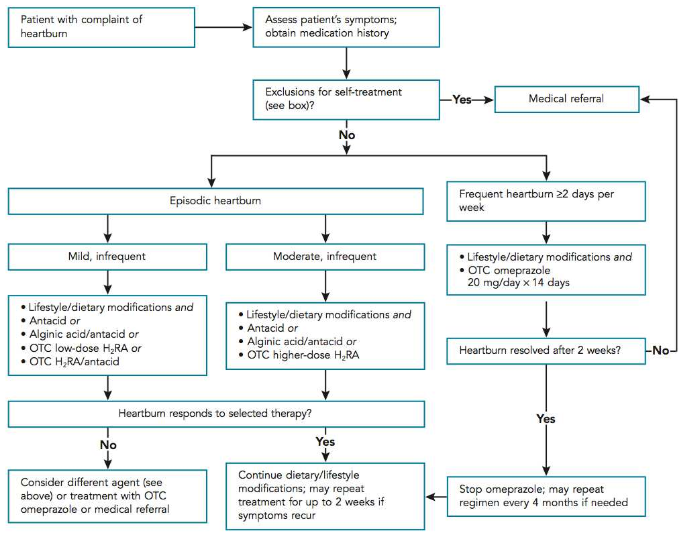
N.B.: some of the OTC options are not available in all countries.
- Follow-up action:
- The goals of self-treatment are to become symptom-free and restore an optimal quality of life, by using the most cost-effective therapy.
- If satisfactory and complete relief is not achieved, patients are recommended to visit a health-care professional for diagnostic evaluation.
3.6.2 Pharmacist
- A check should be made for any medications that may be contributing to heartburn:
- Bisphosphonates, aspirin/nonsteroidal anti-inflammatory drugs (NSAIDs), iron, potassium, quinidine, tetracycline
- Zidovudine, anticholinergic agents, alpha-adrenergic antagonists, barbiturates
- β2-adrenergic agonists, calcium channel blockers, benzodiazepines, dopamine
- Estrogens, narcotic analgesics, nitrates, progesterone, prostaglandins, theophylline
- Tricyclic antidepressants (TCAs), chemotherapy
- If any of these drugs are being taken, suggest referral to a general practitioner/family physician
- Management:
- The patients should avoid NSAIDs, potassium supplements, bisphosphonates, and other trigger medications.
- In addition to lifestyle and dietary measures, aluminum salts, magnesium salts, calcium salts, a combination of aluminum and magnesium salts, alginates, or antacids/H2RAs or PPI (in OTC dose) should be considered.
- Alarm signals and follow-up action:
- If a patient is > 60 or aged 50–60 and has risk factors for cancer (e.g., tobacco, alcohol, obesity), referral to a physician.
- If there is no improvement after 2 weeks, referral to the general practitioner/family physician.
3.6.3 Primary care doctor
- Diagnosis:
- Patient history, health status, medications, age
- Allergies, family history of food allergies or eosinophilic esophagitis, hereditary angioedema; to be differentiated from food intolerances
- Symptoms, duration, frequency, situation, remedies
- Alarm signals
- Management:
- Evaluate the response to PPI treatment.
- There is no evidence that increasing the PPI dose in response to an inadequate response to a standard dosage is useful. However, taking a PPI twice daily 30 min before food may increase the response in some patients. “Blind” escalations of PPI dose are a major contributor to costs.
- The patient should avoid any food or drink after the end of the last meal of the day—no “nightcap.”
- If treatment is satisfactory, the dose should be reduced to the lowest effective level.
- If treatment fails, endoscopy should be considered.
- Biopsies should be taken if there are visible abnormalities, if dysphagia is an additional presenting symptom, or if H. pylori infection or eosinophilic esophagitis is a diagnostic consideration.
- Follow-up action:
- An annual review should be offered to patients who require long-term management of symptoms.
- Routine endoscopy is not necessary for patients without alarm signs; urgent referral for endoscopy is needed for patients > 55 years with unexplained, persistent, recent-onset dyspepsia.
- Early endoscopy could be considered in areas with a high incidence of gastric cancer.
3.6.4 Specialist
Full details of the specialist management of heartburn are beyond the scope of this guideline, and the reader is referred to the relevant guidelines on the management of GERD [49,50].
Fig. 2 Clinical algorithm for recurrent heartburn. Source: www.romecriteria.org.
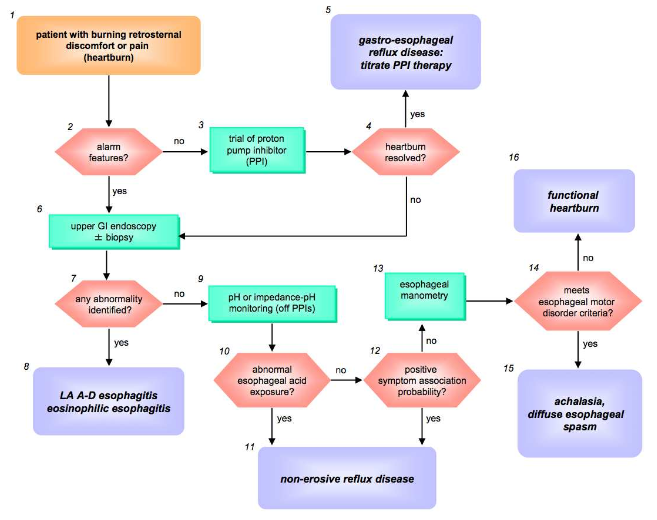
4.1 Definition and description
- A chronic, localized or diffuse unpleasant feeling or pain in the abdominal cavity.
- Dyspepsia (or indigestion) is a chronic or recurrent pain in the upper abdomen, with a sensation of fullness and early satiety when eating. It may be accompanied by bloating, belching, nausea, or heartburn. It is frequently associated with GERD and may be the first symptom of peptic ulcer disease and occasionally of gastric cancer.
4.2 Epidemiological notes
- Several studies have reported prevalences of abdominal cramping and pain in the range of 10–46% of the general population [4].
- The prevalence is higher in women than in men, and a similar prevalence is found across different age groups.
Fig. 3 The prevalence of abdominal cramping and pain in all age groups in the general population. Source: Quigley et al. 2006 [4].
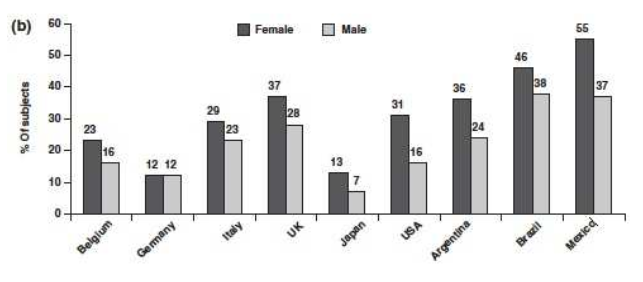
- There are considerable differences between cultures in the view of the overall concept of IBS and the terms used to describe the symptoms that occur during an attack or episode. While abdominal pain and cramps—and to a lesser extent bloating, diarrhea, and constipation—are typically regarded as being the most troublesome symptoms, there are significant between-country variations in the occurrence rates for these symptoms. These variations may also reflect differences in culture, language, or expression that make interpretation problematic. The prevalence of abdominal cramping and pain, and the related medication use and use of OTC products and antispasmodics in particular, are consistently high in the general population across different countries. On the other hand, there are significant differences between the same countries in the nomenclature used to describe symptoms, as well as in the frequency, severity, sufferer impact and sufferer response to the same symptoms [4].
4.3 Diagnostic/symptoms remarks
- Abdominal pain accompanied by disordered defecation is usually labeled IBS [51,52].
- The Rome III diagnostic criteria for functional abdominal pain disorder are:
- Continuous or nearly continuous abdominal pain.
- No, or only an occasional, relationship between pain and physiological events (e.g., eating, defecation, or menses).
- Some loss of everyday functioning.
- The pain is not feigned.
- There are insufficient symptoms to meet the criteria for another functional gastrointestinal disorder that would explain the pain.
- The criteria have been fulfilled for the previous 3 months, with symptom onset at least 6 months before diagnosis.
4.4 Differential diagnosis
- There are many possible causes of abdominal pain. The focus here will be on common causes of chronic abdominal pain, with pain/discomfort as the main presenting feature. However, it must be borne in mind that specific GI conditions may cause severe, acute abdominal pain, including: appendicitis, perforated peptic ulcer, strangulated hernia, diverticulitis, small and large bowel obstruction, superior mesenteric arterial thrombosis, pancreatitis, and cholecystitis.
- Irritable bowel syndrome (IBS)—abdominal pain is associated with bowel movements and leads to frequent, loose(r) stools or infrequent hard(er) stools with relief from defecation.
- Enteric infections—diarrhea and vomiting are prominent symptoms; pain, typically cramping in nature, may also feature.
- Specific food intolerance—FODMAPs, lactose [32,53,54]. FODMAPs are poorly absorbed short-chain carbohydrates and monosaccharides and include fructans, galactans, fructose and polyols; the acronym stands for “fermentable, oligosaccharides, disaccharides, monosaccharides, and polyols.”
- Functional dyspepsia or epigastric pain disorder (EPD): pain is localized to the epigastrium, is intermittent and does not meet the criteria for gallbladder disease or sphincter of Oddi dysfunction.
- Peptic ulcer disease: the rates remain high in many countries, due to H. pylori infection and use of acetylsalicylic acid (ASA) and NSAIDs.
- Unrecognized constipation.
- Celiac disease.
- Hepatic congestion/swelling of any cause—e.g., right-sided heart failure, steatosis, hepatitis.
- IBD, especially Crohn’s disease.
- Chronic mesenteric ischemia (older patients): pain is exacerbated by eating (intestinal angina) and is out of proportion to the physical examination; new onset in older patients, history of vascular disease, symptoms of nausea, vomiting, and prominent weight loss; diarrhea may be present.
- Gynecological pathology—pain associated with, and worsened by, menses; it should be remembered that IBS is often worse with menstruation. Gynecologic causes of chronic/recurrent abdominal pain/discomfort are: endometriosis, dysfunctional uterine bleeding, pelvic inflammatory disease, and ovarian cancer (may mimic IBS or dyspepsia and be difficult to detect). Ruptured ovarian cyst and ectopic pregnancy present with acute abdominal pain. A pelvic examination should be carried out, and one should consider pelvic ultrasound and/or referral to a gynecologist.
Table 1 Pain location and differential diagnosis
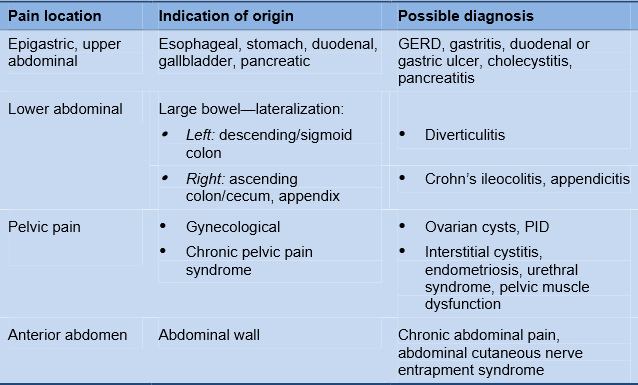
GERD, gastroesophageal reflux disease; PID, pelvic inflammatory disease.
Table 2 Pain trigger/relief and differential diagnosis
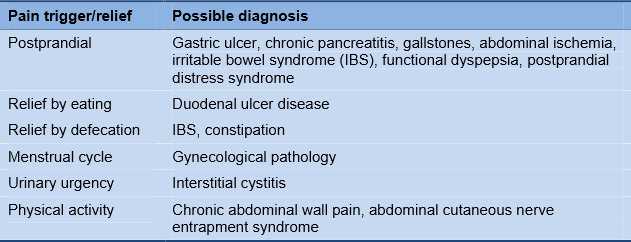
4.5 Alarm features
- Abnormal findings on physical examination
- Unintentional progressive weight loss
- Age at onset
- GI bleeding
- Family history of abdominal cancer
- Laboratory abnormalities: anemia, hypoalbuminemia, abnormal liver function tests, elevated ESR or CRP, positive fecal occult blood test
- New onset of symptoms without obvious trigger(s)
4.6 Abdominal pain/discomfort—management cascade
- The community prevalence, severity, health-care seeking, and medication use related to abdominal cramping/pain are high overall, but vary considerably between countries [4]. In the United States and Latin America, greater use of medications for abdominal pain has been reported than in Europe (90% versus 72%). Antispasmodic drugs have been most popular in Latin America and Italy, antacids in Germany and the United Kingdom. Drug therapy has reduced the duration of episodes (by up to 81% in Brazil).
- Medication is mainly taken on demand to relieve a pain episode. In a report on expectations of treatment, “fast onset of action” was ranked as the most important aspect, followed by “highly effective” and “well tolerated.” The choice of drug was mostly determined by a physician (approx. 50%), followed by friends, relatives, or fellow sufferers. Advertising appeared to play a minor role (0–6%), except in the United States (18%) [5].
Fig. 4 Pattern of intake of medication taken for abdominal cramping and pain. Source: Mueller-Lissner et al. 2010 [5].
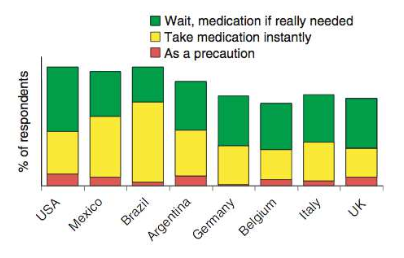
Fig. 5 Major therapeutic classes used per country. Source: Mueller-Lissner et al. 2010 [5].
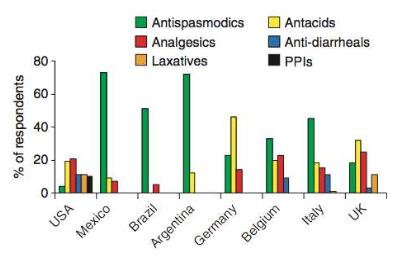
- A matter of great concern is that during the 10-year period 1997–2008, opioid prescriptions for chronic abdominal pain more than doubled in the United States [55]. No study has shown that opioids are effective for treating chronic abdominal pain; long-term use of opioids may worsen other gastrointestinal symptoms, particularly constipation, nausea, and vomiting, and may lead to addiction.
4.6.1 Abdominal pain/discomfort self-help
- Warning signals to seek medical care rather than self-help:
- Continuing symptoms despite a full course of prescription or OTC medications
- Vomiting
- Unintentional weight loss
- Symptoms increase over time and interfere with daily activities
- Alarm signals to consult a doctor immediately:
- Pain that starts all over the abdomen but settles into one area, especially the right lower quadrant
- Pain accompanied by fever over 38.3 °C or 101 °F
- Pain with inability to urinate, move the bowels, or pass gas
- Severe pain, fainting, inability to move
- Pain that seems to come from the testicles
- Chest pain accompanied by pain radiating up into the neck, jaw, arms, with shortness of breath, weakness, irregular pulse or sweating
- Continuous nausea, vomiting, or diarrhea
- Extreme discomfort / pain in abdomen
- Vomiting of blood or black material
- Black or bloody bowel movements
- Self-medication/self-help
- Where appropriate: OTC medication for diarrhea and constipation
- Lifestyle changes and dietary interventions
4.6.2 Pharmacist
- Management:
- The current standard treatment for IBS generally consists of a symptom-directed approach, with medication aimed at alleviating pain, constipation, and/or diarrhea [51,52].
- Evidence is now beginning to suggest that specific dietary intolerances should be considered [32,53,54].
- Other dietary strategies may also be of benefit, such as increasing fiber in the diet in the presence of constipation or probiotic with evidence of efficacy in IBS.
- Antacids and PPIs are probably inappropriate for treating abdominal cramping and pain [5]—although laxatives may cause cramps, they can actually reduce pain in more severely constipated patients.
4.6.3 Primary care doctor
- Alarm signals:
- Refer for upper and/or lower endoscopy (as appropriate) in patients aged > 50 y with alarm symptoms: weight loss, anemia, hematemesis, melena, bright red, bloody stools
- Diagnosis:
- Patient history
- Physical examination—light and deep palpation, auscultation, percussion, rectal, or pelvic examination, penis and testicles, check for dehydration and jaundice
- Psychosocial assessment—history of post-traumatic stress disorder (PTSD), physical or psychosocial abuse, somatization, anxiety, depression, family relationships and functioning
- Standard laboratory tests—complete blood count to screen for anemia and infection, serum electrolytes, glucose, creatinine and urea for metabolic causes; liver function tests, lipase, and amylase, particularly in patients with upper abdominal pain; inflammatory markers; urinalysis and urine culture to help exclude urinary tract infection and interstitial cystitis; fecal occult blood (patient > 50 y); celiac serology; calprotectin test
- Additional tests—stool tests for culture, ova and parasites, and Giardia antigen to screen for bacterial, parasitic, or protozoal causes; urine or serum pregnancy test; testing for H. pylori infection in patients with upper GI symptoms (test type depending on prevalence and test availability—e.g., urea breath test, fecal antigen, or serology); in certain cases with pelvic and lower abdominal pain: vaginal swabs, pap smears, beta-human chorionic gonadotrophin, prostate-specific antigen, and urine cytology
- Management:
- Symptomatic treatment:
- � Anti-muscarinic agents
- � Peppermint
- � Dietary manipulation—FODMAPs, lactose, fructose-free diets
- � Other pharmacologic agents: tricyclic antidepressants (TCAs) or serotonin-specific reuptake inhibitor (SSRI) therapy
- The use of narcotic agents in patients with functional abdominal pain disorder (FAPD) may lead to the development of narcotic bowel syndrome—characterized by increasing use of narcotic medications for pain relief and, paradoxically, with the development of hyperalgesia
- Follow-up action:
- Reassessment after 3–6 weeks of symptomatic treatment
- Consider the Rome III Psychosocial Alarm Questionnaire for Functional Gastrointestinal Disorders to identify markers of serious psychosocial disturbance [56]
- Additional diagnostic procedures—laboratory and radiologic examinations
- Referral to GI specialist [57], pain clinic
4.6.4 Specialist
Fig. 6 Clinical algorithm for constant/recurring abdominal pain/discomfort. Source: www.romecriteria.org.
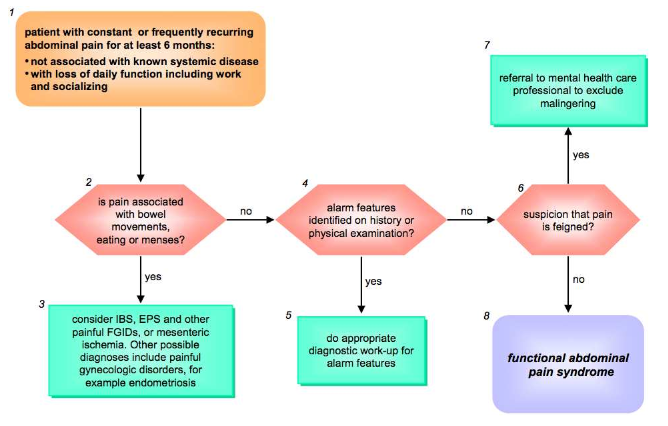
Fig. 7 Clinical algorithm for abdominal pain/discomfort in patients with disordered bowel habit. Source: www.romecriteria.org.
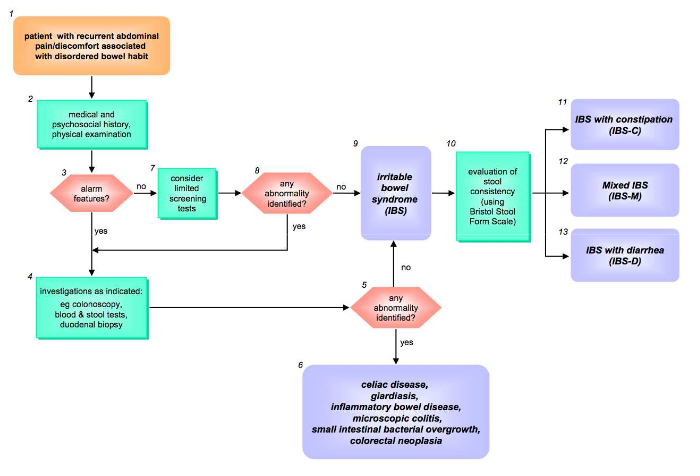
5.1 Definition and description
- Bloating, postprandial abdominal fullness, and distension are rather vague entities and difficult to define, with bloating described as a “feeling of increased pressure within the abdomen.”
- Language issues:
- In English, bloating and distension are differentiated: bloating is a symptom and distension is an observable and measurable expansion of the abdomen. This distinction is not possible in several other languages, such as Spanish.
- In Western countries, “early satiety” refers to a feeling of overfilling of the stomach soon after starting to eat, disproportionate to the quantity of food taken. By contrast, “bloating” refers to a feeling of fullness, without any relation to prior food intake to explain this feeling.
- Patients often find it hard to describe exactly what they mean by bloating, and many different terms may be used: “have to loosen clothes,” “see distension of abdomen,” “feeling uncomfortably full.”
- Related symptoms present in some patients—excessive gas (flatulence), frequent burping (eructation), and abdominal rumbling (borborygmi).
- Bloating in functional gastrointestinal disorders characteristically has a diurnal pattern (absent in the morning, worse in the evening) and is almost diagnostic of an FGID. However, when it is constant, it should be regarded as an alarm feature—e.g., for ovarian cancer or ascites.
- The etiology is complex and may involve a number of factors: gas trapping, abnormal diaphragmatic and gut wall movements, visceral hypersensitivity, etc. If the patient’s abdominal girth is measured, it may or may not be increased (i.e., true distension), although the patient feels it is and is convinced that it is. At other times, the trousers or skirt have to be undone because there is distension.
- Abdominal bloating can be bothersome and a hindrance in daily life, and distension is an embarrassment when it occurs frequently.
- In the upper GI tract, gas usually comes from swallowed air (aerophagia) or air contained in food, drinks, etc; in the lower tract, gas results additionally from fermentation (H2 and CO2).
5.2 Epidemiological notes
- Abdominal bloating is a very common symptom that affects 10–30% of the general adult population.
- In a survey of householders in the United States, 16% of the population reported bloating or distension, and three-quarters found it to be moderate to severe. Almost half (43%) reported using a medication for it [1]. In one study in the general population in Iran, which reported a prevalence of 2–9% for bloating, 96% of patients with IBS had bloating and 60% reported it as their most bothersome symptom. Two studies reported the prevalence of functional bloating as 2% and 10% according to the Rome III and Rome II criteria, respectively [58].
- In a Canadian study, 5% of the Canadian population (2.3% of men and 7.9% of women) experienced one or more lower GI symptoms—excluding those reporting abdominal pain alone. Overall, 78% of the participants experienced two or more symptoms. Bloating was the most common symptom (75%) and abdominal pain the most bothersome and most severe [59].
5.3 Diagnostic/symptoms remarks
- Imaging studies are of little value for establishing the diagnosis of bloating. They may help rule out an obstruction or a condition that could predispose the patient to small-intestinal bacterial overgrowth (SIBO).
- Health-care providers may be concerned that symptoms of bloating and distension are signs of SIBO and may initiate empirical therapy for bacterial overgrowth; the status of SIBO in this context remains controversial.
- Bloating is usually benign, but can cause significant difficulties in relation to the ability to work and participate in social or recreational activities. It is also related to increases in sick days, physician visits, and medication use. Appearing to be pregnant may embarrass females.
- Rome III criteria (http://www.romecriteria.org/education/clin_algorithms.cfm) for functional bloating must include both:
- A recurrent feeling of bloating or visible distension on at least 3 days per month during the previous 3 months
- Insufficient criteria for a diagnosis of functional dyspepsia, irritable bowel syndrome, or other functional GI disorder
- The criteria must be fulfilled for the previous 3 months, with symptom onset at least 6 months before the diagnosis.
5.4 Differential diagnosis
- GI causes or associations with bloating [60]:
- “Physiological”: air travel, change in diet related to travel—for example, may lead to transient bloating and /or flatulence
- IBS
- Aerophagia
- Anorexia and bulimia
- Gastroparesis
- Gastric outlet obstruction / pyloric stenosis
- Functional dyspepsia
- Dietary factors:
- �Lactose or fructose intolerance
- �Consumption of fructose, sorbitol, or other nonabsorbable sugars
- �High carbohydrate intake
- �Gluten sensitivity
- Celiac disease
- Chronic constipation
- Small intestinal bacterial overgrowth
- Abnormal small intestinal motility (e.g., scleroderma)
- Small-bowel diverticulosis
- Abnormal colonic transit
- Non-GI diseases associated with bloating or distension
- Ascites—e.g., due to congestive heart failure, liver cirrhosis, malignancy
- Distension due to pregnancy, tumors, etc.
- Bloating may be a normal feature of the menstrual cycle
5.5 Alarm features
- Age
- Anemia
- Abdominal findings suggesting fluid or mass
- Sustained visible distension
- Unintentional progressive weight loss
- Coexisting nausea, vomiting, diarrhea
- GI bleeding
5.6 Bloating—management cascade
5.6.1 Bloating self-help
- Diet:
- Split food intake by taking three meals a day, along with two snacks. It is better to increase the frequency of food intake and decrease the quantity per intake (eating less at each meal, rather than having one large meal). Bedtime snacks should be avoided.
- Limit intake of difficult-to-digest carbohydrates such as beans, pulses, broccoli, cabbage, cauliflower, and Brussels sprouts. Instead, eat easily digestible carbohydrates such as potatoes, rice, lettuce, bananas, grapes, and yoghurt.
- Avoid intake of caffeine-containing beverages.
- Reduce foods and drinks containing gas, such as soft drinks or beer.
- Fiber should be introduced gradually into the diet over weeks rather than days, to allow the body to adjust.
- Consume fermented dairy products, containing probiotics with proven benefits on bloating.
- Limit polyol-containing foods—artificial sweeteners such as maltitol, sorbitol, xylitol, and isomaltose.
- Reduce intake of foods high in animal fat, and greasy or fried foods.
- Avoid overeating; do not rush eating and chew food slowly and well.
- Maintain a healthy body mass index—aim to achieve your ideal body weight.
- Avoid foods that ferment in the stomach (can lead to bloating), as well as starchy foods, cabbage, milk and alcoholic beverage—bearing in mind that any diet should be varied.
- Favor protein: a diet based on protein and dairy products, combined with a decrease in sugars and fats, improves bloating.
- Lifestyle—improve exercise practice and posture.
- Medication—over-the-counter preparations containing simethicone and activated charcoal are still being used for gas and bloating symptoms, but their usefulness is questionable. Some studies of probiotic preparations containing bacterial species such as Lactobacillus and Bifidobacterium have reported improvement in bloating and flatulence [61].
5.6.2 Pharmacist
- Any pharmacotherapy should be combined with lifestyle and dietary interventions:
- Combine medications with lifestyle changes.
- Herbal medicine, homeopathy, aromatherapy are sometimes recommended, but without any evidence of efficacy.
- Referral to the physician:
- When bloating lasts several weeks or worsens.
- When other symptoms are present, such as diarrhea or constipation, abdominal pain, vomiting, coughing up blood, weight loss, etc.
- Bloating may indicate more sinister causes if accompanied by weight loss, diarrhea, abdominal pain, occurring especially after food intake, as well as when there is an abdominal mass.
- A total absence of passage of gas and stools, accompanied by severe abdominal pain, requires urgent consultation.
5.6.3 Primary care doctor
- Management when no apparent cause is found:
- Diet—specific trial of exclusion then challenge with lactose, FODMAPs diet [32], avoidance of offending food items; probiotics. However, only one change at a time should be explored.
- Psychological therapies—hypnosis has been shown to relieve bloating in patients with IBS; behavioral therapy may be useful in patients with aerophagia.
5.6.4 Specialist
- Exclude organic disease suggested by comorbid symptoms.
- Address diet—flatulogenic foods, fizzy drinks.
- Address posture.
- Consider probiotics.
- Individualize treatment.
- Consider bacterial overgrowth—appropriate testing.
- Consider laxatives if the patient is constipated.
- Consider a low-dose tricyclic antidepressant [62].
- Consider hypnotherapy.
- Consider neostigmine [63].
6.1 Definition and description
This section focuses on functional constipation, rather than IBS—abdominal pain accompanied by disordered defecation. In clinical practice, the terms “functional constipation” and “chronic constipation” are often used interchangeably, recognizing the chronic nature of the symptoms and excluding IBS. The prominent presence of lower abdominal pain is usually thought to distinguish between IBS and constipation, although the distinction may be difficult to make in practice.
- Constipation is an acute or chronic condition in which bowel movements occur less frequently than usual, or stools are hard, dry, painful, or difficult to pass, or associated with a sense of incomplete or prolonged evacuation—synonyms: dyschezia; obstipation; rectal constipation; slow-transit constipation.
- Fecal impaction is a collection of hard, dry stool in the colon or rectum.
- Symptoms of constipation include:
- Straining and/or discomfort during a bowel motion
- Less frequent than usual bowel motions
- Hard, dry feces or lumpier than usual
- Stomach cramps or bloating
- Discomfort or pain in the lower back or stomach
- Feeling of incomplete emptying after passing feces
- Nausea, irritability, decreased appetite
- Tiredness / fatigue
6.2 Epidemiological notes
- In one study, 5% of the Canadian population (2% of men and 8% of women) were found to experience one or more lower GI symptoms; 51% of these experienced constipation [59].
Fig. 8 Incidence of lower GI symptoms in Canada. Source: Hunt et al. 2007 [59].
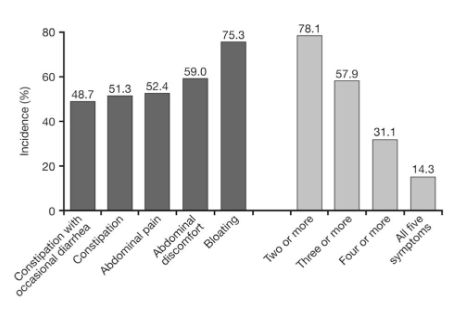
- In a population-based study in Mexico (with interviews conducted by trained physicians using the Rome II/health-care/medication questionnaires and the Center for Epidemiological Studies of Depression scale), the most common FGIDs were IBS, 16% (95% CI, 12.9 to 19.5); functional bloating, 11% (95% CI, 8.2 to 13.9); unspecified functional bowel disorder, 11% (95% CI, 8.0 to 13.6); and functional constipation, 7% (95% CI, 5.3 to 10.1). Uninvestigated heartburn was also very common at 20% (95% CI, 16.2 to 23.4) [64].
- The overall prevalence of constipation in the United States is estimated to be approximately 15% [65].
- Functional constipation as defined by the Rome criteria affects around 8% of the population [66].
6.3 Diagnostic/symptoms remarks
- The Rome III criteria (two or more must be included) for functional constipation are:
- Straining during at least 25% of defecations
- Lumpy or hard stools in at least 25% of defecations
- Sensation of incomplete evacuation for at least 25% of defecations
- Sensation of anorectal obstruction/blockage for at least 25% of defecations
- Manual maneuvers to facilitate at least 25% of defecations (e.g., digital evacuation, support of the pelvic floor)
- Fewer than three defecations per week
- Loose stools are rarely present without the use of laxatives
- Insufficient criteria for irritable bowel syndrome
- Criteria fulfilled for the previous 3 months, with symptom onset at least 6 months before diagnosis
6.4 Differential diagnosis
- Constipation-predominant irritable bowel syndrome (IBS-C) should be considered in cases of chronic constipation with abdominal pain.
- Drug-induced constipation.
- A number of anatomical abnormalities have been linked to difficult defecation, such as rectocele, intussusception, and enterocele; however, they are usually secondary rather than causative phenomena.
- Hypothyroidism—lethargy, increased weight, cold intolerance.
6.5 Alarm features
- Recent change in bowel habit
- Weight loss
- Rectal bleeding
- Age > 50 years
- Family history of colorectal cancer
6.6 Constipation—management cascade
6.6.1 Constipation self-help
- Self-diagnosis—bowel habits vary according to diet and, therefore, geography and ethnicity, but an adult who has had no bowel movement in 3 days, or 4 days for a child, is considered constipated. However, frequency alone is often an inadequate descriptor of a sufferer’s problem, which may relate more to difficulties with the act of defecation or a feeling of incomplete evacuation.
- Alarm signals—consult a doctor if:
- Sudden change in the usual bowel habit—especially if aged > 40
- Painful bowel motions
- Feces are blood-stained or black and tar-like
- Need to use laxatives regularly (every 2–3 days or more)
- Constipation occurs in combination with feeling tired or unwell, vomiting, weight loss, headaches, fever
- Symptoms of constipation for > 7 days with no obvious cause
- Liquid or soft feces leak from the anus
- Self-care strategies:
- Diet:
- Patients with constipation should be encouraged not to miss breakfast, when the gastrocolic reflex is at its height.
- Include foods rich in fiber in the diet—e.g., fruit and vegetables, legumes, whole grains and seeds.
- Gradually increase the amount of fiber in the diet to avoid bloating and wind—if patients find that fiber exacerbates their symptoms (as it may in IBS-C and slow transit), they should avoid overindulging in fiber.
- Choose fruits rich in pectin, such as apples, strawberries, lychees or pears, to increase stool volume and ease passage.�
- Consume fermented dairy products containing probiotics with proven benefits for constipation.�
- Drink approx. 2 liters of drinking water each day—decrease intake of caffeinated, alcoholic, and sugar-rich beverages.�
- Reduce intake of foods high in animal fat, greasy and fried foods.�
- Limit intake of refined sugar—e.g., sweets and rich deserts.�
- Regularize eating times and food habits.
- Exercise and stress:
- �Try to exercise at a moderate level for at least 30 minutes each day.
- �Learn and use relaxation techniques to relieve stress.
- �Practice a healthy lifestyle—exercise regularly and abstain from smoking.
- �Avoid stress—learn how to relax, improve sleeping patterns, exercise regularly, practice deep breathing and adopt good time management techniques.
- Toilet visits:
- �Do not ignore the urge to pass a bowel motion.
- �The toilet sitting position can affect bowel function—lean well forward, with a straight back and with feet supported.
- �Expect a regular bowel action every 1–2 days.
- Ask a doctor/pharmacist for advice—if a medical condition or medicine causes constipation.
- Medication:
- Aim to minimize the use of medication and focus in the longer term on diet and lifestyle changes.
- Simple bulking agents—fiber supplements such as ispaghula, guar gum, psyllium, sterculia; to be taken with adequate amounts of fluid.
- Stool softeners—docusate, poloxalkol; stool softeners are mild laxatives that are widely used and can be helpful for children, but there is little evidence on them.
- Glycerine suppositories—in case of difficulty with rectal emptying.
6.6.2 Pharmacist
- Management:
- Check for drug-induced constipation—opiates, iron therapy, calcium-based antacids, tricyclic antidepressants, antipsychotics, chemotherapy, anticholinergic medicines, antiparkinsonian medicines, antidiarrheal medicines slowing down intestinal transit, clay, or silicates.
- Readily available traditional laxatives are the first-line treatment but are associated with high dissatisfaction rates [67].
- Stimulant laxatives, such as senna, and osmotic laxatives, such as lactulose, may cause abdominal pain and result in watery stool followed by days with no bowel movement, thus mimicking constipation and leading to further doses and excessive laxation.
- Glycerine suppositories.
- With proper instruction, constipation can be managed without drugs most of the time.
6.6.3 Primary care physician
- Alarm signals:
- In the absence of alarm features, routine diagnostic testing is not recommended in all constipated patients.
- If one or more alarm signal is present, there is an indication for colonoscopy; colonoscopy is not a diagnostic test if no alarm features are present.
- Diagnosis:
- Patient history and physical examination
- Description of defecation pattern—stool frequency, form (Bristol Stool Form Scale, BSFS)
- Measures taken to improve situation and results
- Complete blood count, erythrocyte sedimentation rate, C-reactive protein to exclude intestinal occult blood loss or inflammation
- Management:
- Modify diet and lifestyle
- Bulking agents, simple laxatives
- Follow-up action:
- Refer for GI evaluation if constipation fails to improve
- Consider biofeedback technique to correct pelvic floor dyssynergia
6.6.4 Specialist
See the WGO guideline on constipation (http://www.worldgastroenterology.org/constipation.html).
Fig. 9 Clinical algorithm for chronic constipation. Source: www.romecriteria.org.
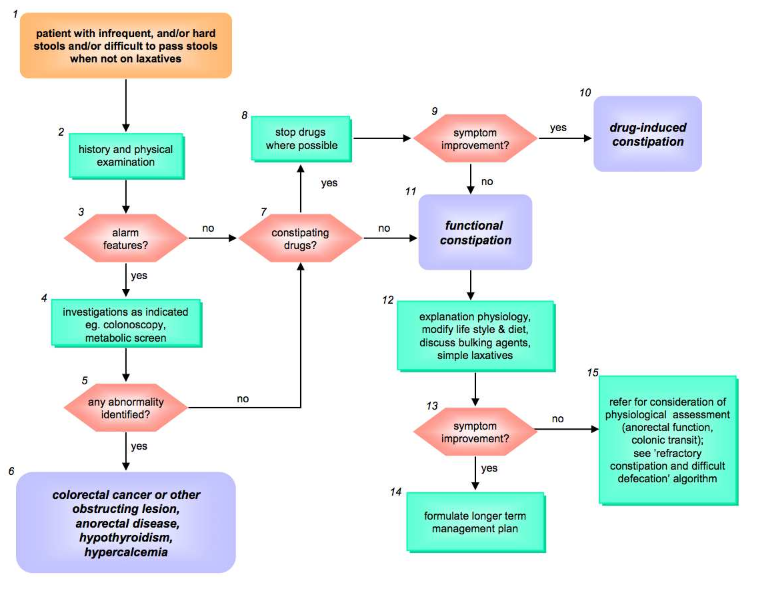
Notes:
- New prescription medicines will probably overtake this, and there is growing skepticism that testing makes a difference.
- Prescription drugs for patients with persistent symptoms who have tried OTC agents: Linaclotide has been approved in the United States and the European Union for the treatment of chronic idiopathic constipation and IBS-C in adults; prucalopride has been approved in the European Union and certain Asian and Latin American countries for the treatment of chronic constipation; and lubiprostone has been approved for both chronic constipation and IBS-C in the United States.
- �There are some new approaches: biofeedback for dyssynergia and sacral stimulation for inertia. Surgery should be considered very, very rarely, and then only in very experienced centers.


